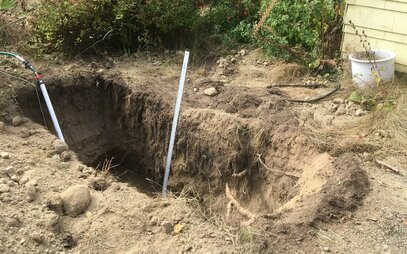In the face of increasing urbanization and climate change, the importance of effective drainage solutions has never been more critical. Sustainable drainage systems (SuDS) have emerged as a viable alternative to traditional drainage methods, helping to manage stormwater, reduce flooding, and improve water quality. One of the key components in designing these systems is understanding the infiltration capacity of the soil. Soil infiltration test play an essential role in assessing this capacity, providing valuable information for the implementation of sustainable drainage solutions. This article explores the significance of soil infiltration tests, their methodologies, and their impact on effective drainage design.
Understanding Soil Infiltration
Soil infiltration refers to the process by which water enters the soil surface and moves downward into the soil profile. This process is influenced by various factors, including soil texture, structure, moisture content, and land use. Infiltration is crucial in managing stormwater because it determines how much water can be absorbed by the soil and how much will run off into drainage systems or water bodies.
In urban areas, where impervious surfaces like asphalt and concrete dominate, natural infiltration is often reduced. This leads to increased surface runoff, which can cause flooding and water pollution. Therefore, understanding soil infiltration rates is vital for designing sustainable drainage systems that effectively manage stormwater.
The Importance of Soil Infiltration Tests
Soil infiltration tests are essential for several reasons:
1. Assessing Site Suitability
Before implementing a sustainable drainage solution, it is crucial to assess the suitability of the site for infiltration. Soil infiltration tests provide data on the rate at which water can percolate into the soil. This information helps engineers and planners determine whether infiltration-based solutions, such as soakaways, permeable pavements, or bioretention areas, are appropriate for a given site.
2. Design Optimization
The results of soil infiltration tests directly influence the design of sustainable drainage systems. By understanding the infiltration capacity of the soil, designers can optimize the size and configuration of drainage features to ensure they function effectively. For instance, if a soil test indicates low infiltration rates, larger storage areas may be required to manage stormwater effectively.
3. Mitigating Flood Risks
Effective stormwater management is critical for mitigating flood risks, particularly in urban areas prone to heavy rainfall. Soil infiltration tests provide valuable insights into how much water can be absorbed, helping to prevent surface runoff that can lead to flooding. By incorporating infiltration-based solutions, cities can enhance their resilience to extreme weather events.
4. Improving Water Quality
Infiltration helps filter pollutants from stormwater, improving water quality before it enters groundwater or surface water bodies. Understanding soil infiltration rates allows for the design of systems that maximize this natural filtration process, thereby reducing the risk of water pollution.
5. Sustainability and Compliance
Many regions have regulations that require sustainable stormwater management practices. Conducting soil infiltration tests not only supports compliance with these regulations but also promotes sustainable land use practices. Properly designed drainage systems can enhance ecosystem functions and contribute to urban green spaces.
Methodologies for Soil Infiltration Testing
There are several methods for conducting soil infiltration tests, each with its advantages and limitations. The most common methods include:
1. Double Ring Infiltrometer Test
The double ring infiltrometer test is a widely used method for measuring soil infiltration rates. This test involves two concentric rings placed in the soil. Water is applied to the inner ring, while the outer ring helps to minimize lateral flow. The rate at which water infiltrates into the soil is measured over time, providing a reliable assessment of the infiltration capacity.
2. Single Ring Infiltrometer Test
Similar to the double ring test, the single ring infiltrometer test uses a single ring placed in the soil. Water is added to the ring, and the rate of infiltration is measured. This method is simpler and quicker but may be less accurate in certain soil types due to potential lateral flow.
3. Tension Infiltrometer Test
The tension infiltrometer test measures infiltration under varying tension conditions, simulating natural soil moisture conditions. This method is particularly useful in assessing how infiltration rates change with different soil moisture levels, providing a more comprehensive understanding of soil behavior.
4. Field Permeability Tests
Field permeability tests, such as the falling head or constant head tests, can also provide valuable data on soil infiltration rates. These tests involve measuring the rate at which water moves through soil columns under controlled conditions, offering insights into the hydraulic properties of the soil.
Factors Influencing Soil Infiltration
Several factors can influence soil infiltration rates, including:
- Soil Texture: Coarser soils, like sand, generally have higher infiltration rates than finer soils, such as clay.
- Soil Structure: Well-structured soils with good aggregation promote better infiltration compared to compacted or poorly structured soils.
- Moisture Content: The initial moisture content of the soil affects its infiltration capacity; drier soils typically have higher infiltration rates.
- Vegetation Cover: Vegetated areas tend to have improved infiltration rates due to root systems that create pathways for water movement.
Conclusion
In conclusion, soil infiltration tests are a crucial element in the design and implementation of sustainable drainage solutions. By providing essential data on the infiltration capacity of soil, these tests help optimize drainage designs, mitigate flood risks, improve water quality, and ensure compliance with sustainability regulations. As urban areas continue to grow and face the challenges of climate change, the need for effective drainage solutions becomes increasingly important. Brands like onn-point exemplify the integration of advanced testing methodologies and sustainable practices, helping to shape resilient urban landscapes where effective stormwater management is a priority. By prioritizing soil infiltration testing, stakeholders can make informed decisions that enhance both environmental quality and community resilience.





Comments